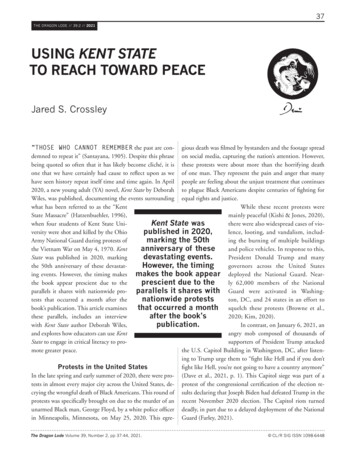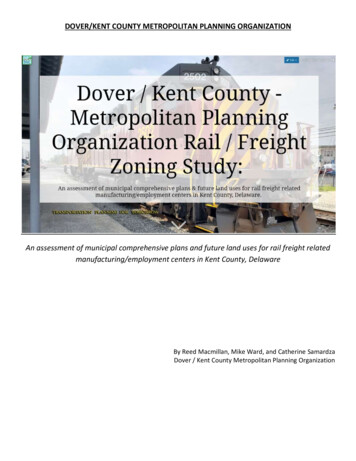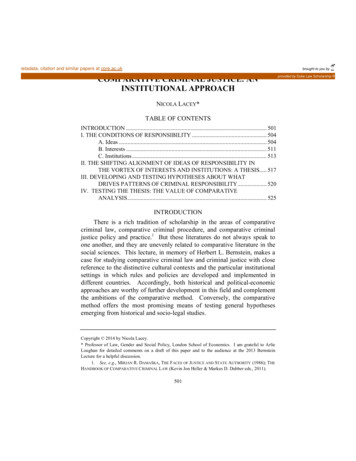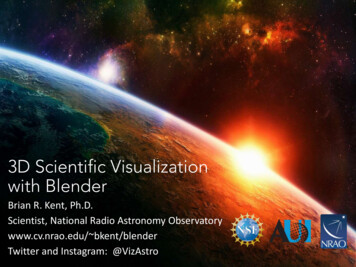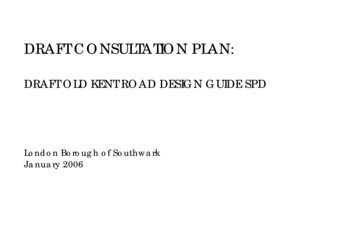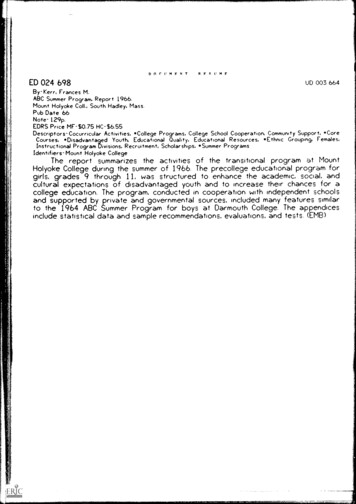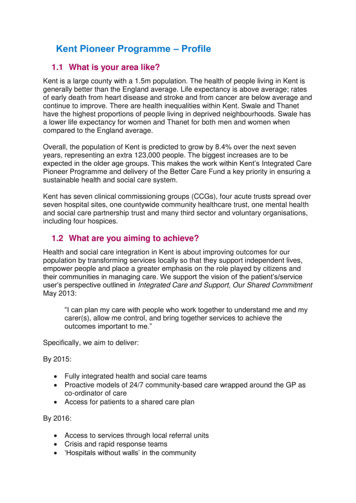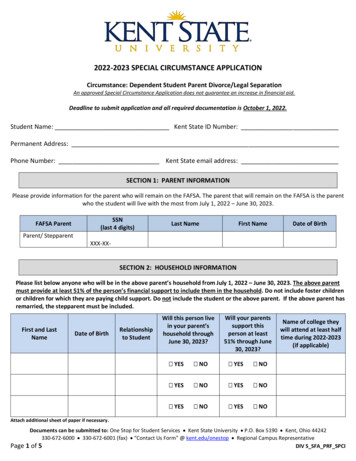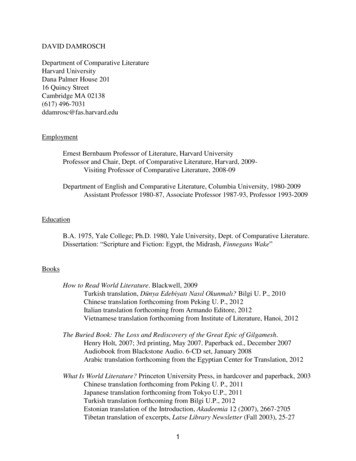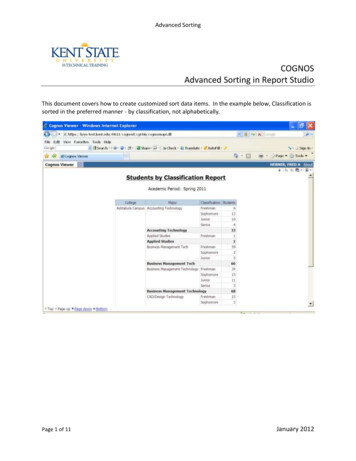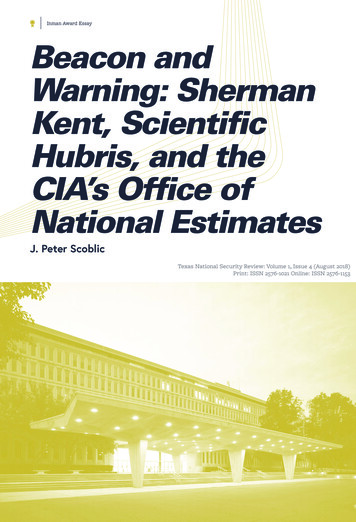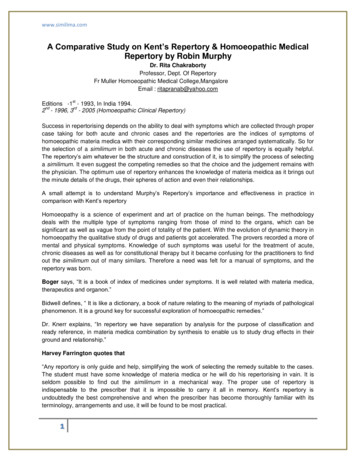
Transcription
www.similima.comA Comparative Study on Kent’s Repertory & Homoeopathic MedicalRepertory by Robin MurphyDr. Rita ChakrabortyProfessor, Dept. Of RepertoryFr Muller Homoeopathic Medical College,MangaloreEmail : ritapranab@yahoo.comstEditions -1 - 1993, In India 1994.ndrd2 - 1996, 3 - 2005 (Homoeopathic Clinical Repertory)Success in repertorising depends on the ability to deal with symptoms which are collected through propercase taking for both acute and chronic cases and the repertories are the indices of symptoms ofhomoeopathic materia medica with their corresponding similar medicines arranged systematically. So forthe selection of a similimum in both acute and chronic diseases the use of repertory is equally helpful.The repertory’s aim whatever be the structure and construction of it, is to simplify the process of selectinga similimum. It even suggest the competing remedies so that the choice and the judgement remains withthe physician. The optimum use of repertory enhances the knowledge of materia meidica as it brings outthe minute details of the drugs, their spheres of action and even their relationships.A small attempt is to understand Murphy’s Repertory’s importance and effectiveness in practice incomparison with Kent’s repertoryHomoeopathy is a science of experiment and art of practice on the human beings. The methodologydeals with the multiple type of symptoms ranging from those of mind to the organs, which can besignificant as well as vague from the point of totality of the patient. With the evolution of dynamic theory inhomoeopathy the qualitative study of drugs and patients got accelerated. The provers recorded a more ofmental and physical symptoms. Knowledge of such symptoms was useful for the treatment of acute,chronic diseases as well as for constitutional therapy but it became confusing for the practitioners to findout the similimum out of many similars. Therefore a need was felt for a manual of symptoms, and therepertory was born.Boger says, “It is a book of index of medicines under symptoms. It is well related with materia medica,therapeutics and organon.”Bidwell defines, “ It is like a dictionary, a book of nature relating to the meaning of myriads of pathologicalphenomenon. It is a ground key for successful exploration of homoeopathic remedies.”Dr. Knerr explains, “In repertory we have separation by analysis for the purpose of classification andready reference, in materia medica combination by synthesis to enable us to study drug effects in theirground and relationship.”Harvey Farrington quotes that“Any reportory is only guide and help, simplifying the work of selecting the remedy suitable to the cases.The student must have some knowledge of materia medica or he will do his repertorising in vain. It isseldom possible to find out the similimum in a mechanical way. The proper use of repertory isindispensable to the prescriber that it is impossible to carry it all in memory. Kent’s repertory isundoubtedly the best comprehensive and when the prescriber has become thoroughly familiar with itsterminology, arrangements and use, it will be found to be most practical.1
www.similima.com(Homeopathy And Homeopathic PrescribingBy Harvey Farrington, M.D., Reprint edition 1997, Pg no.239, 240.)According to Dr. Jugal Kishore,“Homeopathic physician, who is keenly interested in doing the best for his patient in the givencircumstances has a very difficult task regarding the choice of remedies unlike the “allopathic colleagues”.Luckily, one of the great instruments at his disposal for lifting through the more of symptoms of such alarge number of remedies in the Materia Medica is the Homoeopathic Repertory.”st(Evolution of Homeopathic Repertory & Repertorization by Jugal Kishore. I edition 1998 pg no 1)Dr. Kent, in same context, says“The use of repertory in Homeopathic practice is necessary if one is to do careful work. Our MateriaMedica is so cumbersome without a repertory that the best prescriber must meet with only indifferentresults.”(Use of The Repertory by J.T.Kent A.M, M.D & Repertorizing by Margaret Tyler & John Weir. Edition1984-85 Pg no.9)Dr. M.L. Dhawale opines“Kent’s (Repertory) method will appeal to a prescriber with an artistic mind sensitive to the play of emotionadapt at blending the various features that lead to highly characteristic image. This method presupposesa highly trained-sensed patients. Kent’s repertory, although the most exhaustive of its kind, lacks rubricslike uric acid diathesis, moon phases of aggravation, lying knee chest position amelioration etc. For thesethe physician has to refer other works like Boger’s Synoptic key, Boenninghausen’s Characteristics &Repertory, Boger’s general analysis etc. It will, therefore, be apparent that we shall have to be equallyconversant with the various repertories and the manner of their employment”.(Principles & Practice of Homeopathy Part-1 M.L. Dhawale M.D.(Bom) pg no-261)“Kent’s repertory to-day, inspite of its shortcoming, is the greatest repertory planned and the mostpopular. It is said to be the most complete repertoty and is the backbone of homoeopathic literature. Butno repertory is complete and as perfect as possible. We need a repertory which contains only a completeand comprehensive index of symptoms of Materia Medica but also an efficient and easily workablesystem for selecting the similimum.”(Hahnemannian Totality Symposium. Standardization Part-III, Area – D Perceiving Scientific Method:Repertorisation. By M.L. Dhawale Pg no.D.15)Dr. Bidwell comments,“There are several complete repertories now published and the use of any of them will be of untold aid infinding the right remedy. When one has become familiar with their arrangement all the time that is reallyconsumed, is in the taking of the case. Only by this and by constant use can the repertory be acompanion and helper.”(How to use the Repertory with a Practical Analysis of forty HomeopathicRemedies.By Clean IrvingBidwell, M.D. Reprint edition 1984, Pg no.28.)Dr. Tiwari views.“In spite of the above short comings, Kent’s repertory is more complete and useful than others forpractical purposes. Kent was open to all suggestions and he always welcomed further additions anddeletions. Dr. Kent wrote in his preface to the repertory, “Physicians are requested to send in verified and2
www.similima.comclinical symptoms, and to call attention to any error which they may discover in the text”. UnfortunatelyKent could not survive for many years after the publication of his magnum opus”.st(Essentials Of Repertorisation By Dr Shashikant Tiwari 1 edition – 1991, pg no-98)Dr. T.F. Allen quotes,“We venture to hope that future standard works will present a new scheme free from the theoretical ideasconcerning the physiological action of remedies classifying our symptomatology in a form of which willpermit ready reference and enabling numerous proving to be condensed.”(Homeopathic Medical Repertory By Robin Murphy N.D Preface I edition)In above context,Homeopathic Medical Repertory was to be a modern, practical and easy to use reference guide to thevast homeopathic materia medica. To achieve the goal a complete new repertory had to be created. Thealphabetical format was chosen as the most natural method to organise large amounts of information,thus bringing the repertory in line with all the large homeopathic materia medica which are alsoalphabetically arranged. All of Kent’s & Knerr’s sections were used as the foundation for building the newrepertory.Homeopathic medical repertory By Robin Murphy, Preface. Ist Indian edition 1993)Dr. D.P. Rastogi opines,It is a reorganised and expanded version of Kent repertory with Knerr’s format. This book is compact,practical and easy like Kent’s repertory. Dr. Murphy has updated the language of the repertory in manyplaces for which many new generations of homeopathic students will thank him many times. There is abold organisation and expansion of repertorial (analysis) information with many practical rubrics such asthe ones having to do with children, pregnancy. The environment, dreams and delusions including use ofmodern diagnostic terminology as Alzheimer’s syndrome, polycystic ovaries etc. He has created sectionswhich make it easier to locate an experience such as symptoms related to music. Besides the separatesections which have music as a modality. There are plenty cross references and a very useful word indexin the back of the book to locate difficult symptoms.Similibus Homeopathic Digest 1998, Philosophical Background & Application of lesser known and latestrepertories by D.P. Rastogi. Pg no.12A CRITICAL STUDY ON COMPARISON BETWEEN MURPHY’S AND KENT’S REPERTORYWhen one thinks of the bewilderment and despair of uninitiated, engaged in a first tussel with Kent’sstupendous Repertory, one is haunted by the old time story of the man of great authority from Ethiopia,sitting in his chariot, reading as he journeyed, to whom a stranger joined himself with the pertinentquestion. “Understandest thou what thou readest?” and the prompt reply, “How can I, except some manshould guide me?” There are mazes yet that badly need the “Silken clue” Kent’s Repertory is such amaze.Kent’s repertory is based on the philosophy of deductive logic: i.e from general to particular. The generalsare dealt with in depth followed by particulars and minute particulars. A master of materia medica, Dr.Kent noticed that particulars do not fall in line with generals in all cases and hence he emphasized theimportance of generals. In order to understand a person his expression at the level of generals must benoticed and relied upon. The symptoms noticeble at the level of parts come next in the order ofimportance. He said, “Man is prior to the organs. Man is the will and the house which he lives in, is his3
www.similima.combody.” What is expressed on the parts is always preceded by a deviation in the state of health of aperson. Such deviation can be known through expressions at the level of generals.This repertory is built to work the cases from general symptoms to particular symptoms. If a case isworked out merely from particulars it is more than probable that the remedy will not be seen and frequentfailure will result. This is due to the fact that the particular direction in which the remedies in general rubrictend have not been observed and thus to depend upon a small group of remedies relating to someparticular symptom, although not yet observed. But by working other way, from general to particular, thegeneral rubric will include all the remedies that are related to the symptom.As we know that the patient makes himself known to the physician by signs and symptoms and that thetotality of symptoms is the sole representation of the patient, the patient presents a large number andvaried type of symptoms but are they equally important? So it depends on physician's’knowledge of casetaking. “A case well taken is half cured” , one of the master said. For a good homoeopathic prescription agreat deal of information is essential. The homoeopath must know his patient, spiritually, emotionally,mentally, physically and sociologically. He must give as much time as he needs to acquire thisknowledge. Then it is the time to analyse the case. In order to do so we must go about it logically, wemust have a starting point and a place to end. The start is made with the generals and the particulars endit. That is evaluation of symptoms. Kent has evaluated into 3 classes – general, particular and commonand in his repertory he divides each into 3 grades – first, second and third. The generals and particularshave the greatest importance in our prescription.Dr. Kent made use of the earlier materia medica but those which had been clinically observed andrejected numerous symptom of drugs which were sufficiently confirmed. Thus his repertory contains only591 drugs though other drugs were known at that time.thThough Kent’s repertory has continued revisions upto 6 Edition with numerous additions but still it lacksmany rubrics, medicines and especially its language which is very important to comprehend for using. Itslogic as well as its language have already been and even today obstacle to correct use of this repertory.Many authors have attempted to do something about it viz. Dr. P. Schmidt, Dr. Barthel & Klunker,Frederick Schroyens, R.V.Zandwoort and Robin Murphy, etc. They did not only intend to complete therepertory, but they also had in mind the translation of the work.The repertory is, only if one has efficient knowledge of its structural arrangement and understanding ofthe authors’ directions for its use, an unique tool. The homoeopathic Materia Medica contains about 3000drugs with ever enlarging, ever advancing and new contributions which call for revising & updating.Homoeopathic Repertory meets the demand. This is modern alphabetical repertory written by RobinMurphy, N.D, published in 1993, U.S.A & India in May 1994. It is his 4 years’ work for compiling, editing,sorting & updating the work of Kent. It is reorganised and expanded version of Kent and Knerr’s format.There is no distinctive philosophy behind this Medical repertory but as it is based on Kent & Knerr’sformat and Kent’s repertory has the philosophy of its own, Knerr’s one does not have any but it is a verygood reference book. So it serves both the purposes.The Homoeopathic Medical Repertory bears total 67 Chapters in which 30 new chapters are erected with39000 new rubrics and 200000 new additions with updates. All of Kent’s Repertory and some sections ofKnerr’s Repertory were used as the building block for constructing this new Repertory. In each of 67chapters all the rubrics and sub rubrics are sorted into an alphabetical format. Thus Kent’s complicatedsystem (side, time, modalities and extension) is tried to simplify here. Chapters start with Abdomen andend with wrists.4
www.similima.comThe editing of the manuscript involved addition of modern terminology, cross references and correctingerrors. The highest priority was to find clinical informations relevant to modern Homoeopathic practice andto fill in the areas where Kent’s repertory is weak in informations about mental disorders, emergencies,infections, children, pregnancy, major organs viz. Heart, lungs, brain etc. The most important informationis included in chapter generalities that is CONSTITUTIONAL TYPES which act as an eliminating rubric.This repertory contains thousands of new clinical rubrics, especially in the area of mental disorders,emergencies, infections, pathologies and organs. It includes all of the original Kent’s Repertory andadditions from 55 source books viz. Allen, Herring, Boericke, Knerr, Kunzli, Phatak, Barthel & Klunker,Van Zandwoort, Warkentin D.K., Ward J.W., repertories etc, plus thousands of clinical updates from Dr.Murphy’s Homoeopathic & herbal research.The new chapters are - Ankles, Arms, Bones, Brain, Breasts, Children, Elbow, Emergencies,Environment, Feet, Food, Glands, Hands, Heart, Hips, Intestines Joints, Knees, Legs, Liver, Lungs,Muscles, Neck, Nerves, Pelvis, Pregnancy, Pulse, Shoulders, Toxicity, Wrists.The new emergency rubrics and clinical rubrics like allergic reactions burns, coma, dehydration, drugoverdose, motion sickness, shock, sunburn, surgery, tetanus, A.I.D.S, allergies, auto-immune disorder,cancer, compulsive-obsessive disorder, diabetes, endometritis, gastroenteritis, hepatitis, mononucleosis,multiple sclerosis, parkinson’s disease, vaccination etc.The second edition of Homoeopathic Medical Repertory is brought out in 1996. Now it contains 70chapters. Another 3 new chapters are created, those are constitutions, diseases and headaches. Morethan 20, 000 copies already are sold.Plan &constructionChapters1st edition2nd““3rd-67-70-78-1548-1602Remedy1st edition2nd“Information from the cover/publisher2nd EDITION70 Chapters - 3 new additionsNew Chapters -Constitutions, Diseases, Headache.New additions- 40,000 new rubrics, 2,00,000 new additions3rd EDITION - Title changedto Homeopathic Clinical Repertory78 Chapters: - 8 New chaptersNew chapters - Cancer, Fainting, Gallbladder ,speech, spleen,taste Vaccinations, Weakness,rdInformation on 3 edition :-5
www.similima.com1. Original name from 19902. 400 pages larger than the 2nd edition of theHomeopathic Medical Repertory3. 20,000 new rubrics4. 100,000 new additions5. Expanded cross references, remedy list and word index6. Hundreds of new remedies7. New layout and formatting8. Large new clinical chapter and nine other new chapters9. New burgundy coverThe comparative study is done with 1repertorystedition of Murphy and 6thIndian edition of Kent’sCOMPARISON OF PLAN AND CONSTRUCTIONTo find out a rubric at its appropriate place it is imperative to know plan and construction i.e., thearrangement followed in the Repertory. The plan and construction are studied here through comparisonof both the repertories:MURPHYKENTPhilosophyGeneral to particularGeneral to particularPlan and construction67 chapterThirty two new chapters. They are follows:Ankles, arms, blood, bones, brain, breast, children, delusion,dream, elbows, emergency, environment, feets, food, glands,hands, heart, hips, intestine, joints, knees, legs, limbs, liver,lungs, muscles, nerves, pregnancy, pulse, shoulder, toxicity,wrists.Chapter extremities is a very big chapter in Kent which is splithere into around 14 small chapters almost according toanatomical divisions as follows:Ankles, Arms, Bones, Elbows,Feet, Hands, Hips, Joints, Knees, Leg limbs, Muscles, Shoulders,wrists.Chapter Urethra and Bladder are made into one chapterBladder. Chapter containg rubrics on urinary organs are madeinto 3 chapters here.They are Bladder, kidney and urine.Chapter prostate is included in the chapter Male.Vital organs are created separate chapters viz. Brain, liver,637
www.similima.comlungs, heart, intestine.Chapter head is split into chapter head and brainChapter chest is divided into chest, breast, heart and lungsGeneralities chapter has given birth toàemergency, nerves, blood, toxicity, food (partly)Arrangement of chaptersAlphabetical order.i.e,environment,Rubrics on urinaryorgansaredistributedinto5small chapters asfollows : Bladder,Kidney,Urethra,Prostate and urineAbdomen,Ankle natomical order with certain exceptionsas follows: Mind, vertigo, head, eyes----------- generalities.Total no. of medicines1548624Terminology changed talia MaleFemaleGenetalia Female.Total No ofAdditions39, 000 new rubricsand 200, 000 new additionAnd updatesGradationsSTAPH--- 1st, marks----3Staph---1st , marks ----3Staph--- 2nd, marks----2Staph---2 nd , marks ----2Staph--- 3rd, marks----1Staph---3 rd , marks ----1Rubrics & Subrubrics ArrangementAlphabetical order Each rubric starts with generalsymptoms with a list of large group ofmedicines followed by Alphabeticallisting of sub-rubrics. Kent’s STMEnot followed here.7Alphabetical order Rubrics start with general symptoms with a list oflarge group of medicines followed bySIDESst1 right - Left
www.similima.comTIME - Day timeMorningSIDES st1 left side - right sideForenoonTime –NoonafternoonAfternoon etc. i.e. Clock wise.morningModalities-alphabetical order including causativemodalities accompanimentSpecific time—a.m to p.mSpecific time – - a.m to p.m.Rubric-Pain:Types of pain are arranged alphabetically as a main rubricstviz. In each chapter (almost all) 1 rubric-abscess then—aching painPain rubric starts with location of general group of medicinefollowed by alphabetical listing of all types of modalitiesincluding accompaniment and time modalities, extension etc.Each type of pain begins with general affection followed byalphabetical listing of sub-rubrics about modalities, extension,times, sides and accompaniments, then particular locationwhich follows again above orderPain starts with generalsymptom with a list of agroupofmedicinesfollowed by Side, time,Modalities & ExtensionThen, particular locationswhich again follows sameorder.Then comes types of painlike aching, biting etcwhich again follows sameorder.Rubric EruptionLocation with large group of medicinesfollowed by sub-rubrics. Rubrics ofalphabetical listing of different types oferuptions (including colour and characters)sensation, modalities- like - Eruption with large group of remediesfollowed by alphabetical listing of subrubrics of - types (including colour clinicalcondition, character)Bloches, Burning, Copper Coloured,Crusty,Dry, Itching, Miliary, Pimples, Red etcSensation, Modalities, e.g- Boils, Bloches,Burning, Copper coloured, Crusts, Dry,Eczema, Herpetic, Miliary, Psoriasus,Urticaria, Vesicular. Etc.The pathological or diagnostic rubrics aremade main rubrics-likeNext sub-rubrics onBoils,Dermatities,Ectema,Psoriasis, Urtcaria, etc.,Particular location which again followsabove order.Herpes,Rubrics Time ModalitiesAlphabeticallyArrangement is ClockwiseLike - Afternoon1 Day time8st
www.similima.com- Day timeMorning- Morning etcForenoonEach one again starts withgeneral symptoms with a list ofa group of medicines followedby - Specific time ModalitiesNoonAfternoon etc.1 p.mEach again starts with general symptom with a list of agroup of medicines followed by other modalities like-3 p.m. etcMorning - RemediesOther medalitiesBed in – Remediesand extension etc., which arealphabetically arrangedThis arrangement is followed ineach chapter.Break fast during etc.Then comes specificTime - 3 a.m- 4 a.m etc.But above order is not strictly followed in eachchapter. Thus order is followed in cough, chill, fever,perspiration etc.Other way of arrangement1st ClockwiseEach one starts with general symptoms with a list agroup of medicenes followed by- Specific time modalities 3.am , 4 a.m.-Other Modalities and causative modalities etc.In head, ear, nose, eyes, abdomen, etc.Many Rubrics are provided with their proper meaning.Like –Amaunosis – paralysis of optic nerveChemosis – Oedema of ConjuntivaHomsickness – NestalgiaDiscontented – dissatisfiedDictatorial- domineeringTerminology changed or simplified - Rubrics9
www.similima.comChildbirth - Parturition (Pregnancy)Stone -CalculiDecay - CariesGoosebump -GoosefleshBedwetting - Urination, involuntaryFormication -CrawlingTrembling -FlatteringSterturous -Puffing (Breathing)Inflammation of particular part or region given directly like – - InflammationCystitis - Inflammation, bladderUrethritis -Inflammation, UrethraBleeding -HoemenhargeEjaculation - Seminal emission(male)Discharge (Female) -Leucorrhoea(female)Belching - Eructation(stomach)Insomnia - Sleepiness(sleep)Food undigested culosisPthisisNose bleedEpistaxisAllegic Rhinitis - Hay feverFarsightednessBlindness - HypermetropiaNearsightedness - loss of vision - myopiaTypes of Pain Sensations1.Aching pain101.Aching
ows, as from4.Boring4.Boring5.Broken sensation as if5.Bruised, sore6.Bruised ting9.Bursting9.Cleaving, cutting and darting10. Clawing10. Come off, pain as if top of headwould11. Constricting11. Constricting12. Cramping12. Cramping13. Crushed, pain as if,14. Shattered, beated to pieces15. Creeping16. Cutting17. Digging / Boring18. Dragging19. Drawing20. Dull pain21. Formicating22. Foreign body in sensation23. Growing24. Grasping25. Grinding26. Griping27. Hacking28. Hammering29. Headache1113. Crushed, as if shattered, beaten topieces14. Cutting15. Digging(Boring)16. Drawing17. Dull pain18. Flying(wondering)19. Foreign body as if20. Gnawing21. Grasping22. Grinding23. Griping24. Grumbling25. Hacking26. Jerking27. Lacerating
www.similima.com30. Humming28. Lancinating31. Jerking29. Nail, as from a32. Labour pain30. Open, as if33. Lancinating31. Opening and shutting34. Maddening32. Pecking35. Nails pain as if from33. Pinching36. Neuralgic pain34. Plug, peg or wedge, as from a37. Paralytic pain35. Pressing38. Pecking36. Pulled, sensation as if hair were39. Pinching37. Pulling like pulsating40. Plug peg or wedge, as from38. Shattered, bruised41. Pressing(bursting, drawing)39.Shooting,shocks, stitches.cutting,lancinating42. Pricking40. Smarting43. Pulled pain, sensation as if hair were41. Sore, bruised, sensitive to pressure.44. Pulling, pain like42. Sprained sensation, back of head.45. Pulsating, throbbing43. Splitting (see bursting)46. Rheumatic pain44. Stabbing (see cutting)47. Sharp pain45. Sticking (see stitching)48. Shattering46. Stitching49. Shooting47. Stunting (see stupefying)50. Smarting48. Tearing, rending51. Stinging, sticking49. Tightening (see drawing tightening)52. Sore pain50. Torn, as if Ulcerative53. Sprained sensation51. Wedge, like(see plug)54. Stunning pain, stupe-fying55. Stabbing56. Tearing pain12
www.similima.com57. Twinging58. Torn pain , as if (see sore or tearing)59. Ulcerative pain60. Violent61. Wandering pain62. Waves of pain (see paroxysmal)stCHAPTERS – 1 Hearing8.Brain8.Nose9.Breasts9.Face10. Brathing10.Mouth11. Chest11.Teeth12. Children12.Throat13. Chills13.External Throat14. Coughing14.Stomach15. Delusions15.Abdomen16. Dreams15.Rectum17. Ears16.Stool18. Elbows17.Urinary Organ19. Emergency18.Bladder20. Environment19.Kidney13
www.similima.com21. Eyes20.Prostate Gland22. Face21.Urethra23. Feet22.Urine24. Female23.Genitalia25. Fever24.Genetalia Female26. Food25.Larynx & Trachea27. Generals26.Respiration28. Glands27.Cough29. Hands28.Expectoration30. Head29.Chest31. Hearing30.Back32. Heart31.Extremities33. Hips32.Sleep34. Intestine33.Chill35. Joints34.Fever36. Kidneys35.Skin37. Knees36.Perspiration38. Larynx37.Generalities39. Legs40. Limbs41. Liver42. Lungs43. Male44. Mind45. Mouth46. Muscles47. Neck14
www.similima.com48. Nerves49. Nose50. Pelvis51. Perspiration52. Pregnancy53. Pulse54. Rectum55. Shoulders56. Skin57. Sleep58. Stomach59. Stool60. Teeth61. Throat62. Tongue63. Toxicity64. Urine65. Vertigo66. Vision67. WristsCOMMENTS ABOUT EACH CHAPTERIN BOTH THE REPERTORIESMurphyKent1. Abdomenst1 chapter.Total no of rubrics – 20314thchapterTotal on of rubrics –135Cross references - 12Cross references – 32This chapter contains the rubric on external abdomen,hypochondria, hypogastrium, inguinal glands, mesenteric15Rubricson
www.similima.comglands, and peritonium.Intra-abdominal structures like liver, intestines are as aseparate chapter and spleen, pancreas are in chapterglands.hypochondria,hypogastrium, inguinalregion, liver, spleenand pancreas.Total no. of new rubrics are around 70, they are like –Blood flowed back as if, Board, across hypogastrium,sensation of, Draw in, Labour like pain, Peritionitis,Opression as ifTotal no. of pain sensations are 31,new – 5. They are –Bearing down, digging, rheumaticsharp pain, stabbing knife as if.26Rubrics updated / simplifiedDropsy – ascitiesCrawling – formicationFlattering – trembling etcDropsyAddition of medicines : under the Rubric Veinsdistended - 31CrawlingFlattering etc22. AnkleRubrics on ankle and tendoachillis areseperated from chapter extemities of Kentwith addition from other source books.No. such chapter in KentRubrics on ankleschapter extremities.givenTotal no. of rubrics –59Cross references - 0New rubrics -Total no. of rubrics – 49Cross references – 2Achillis tendon with allSub-rubrics.Dislocation, as if feeling.Addition of medicines – under rubricHeaviness, ankle – 916Tendo achillis – 2 rubricsin
www.similima.comInflammation, ankle – 61Injuries, ankle –11353. ArmRubrics related to forearm & upper armThere is no separate chapter forarm. All rubrics related to arm aregiven in chapter extremities.Total no. of rubrics – 115Rubrics added – 54. Backthth4 chapterTotal number of rubrics: 12630 chapter82Cross reference– 210This chapter contains rubrics on lumbar,scapular, spine and thoracic region.Character of pain sensation – 38Rubrics are on cervical, dorsal,lumbar, sacral, coccyx, spineand scapular regions.28New additions in same as follows ation, throbbing, etc.Types of pain in Kent’s not found – clawing,shooting and stitchingTotal no. of new rubrics added : 18They are like – Ankylosing spondylitis, discssyndorme, slips or ruptured, pott’s disease, etc5. BladderRubrics are related to bladder urethraurination and meatus.Total number of rubrics – 132Cross references – 3Rubrics added – around – 20They are like –Atony, cold, agg., complaints after,17Rubrics on bladder & urination.Rubricson urethra and meatus are in chapterurethra.Total no. of rubrics – 59Cross-references -6
www.similima.comcystocele, excoriation, meatus, urethraprolapse, raw, sensation if etc.Sub-rubrics – under gonorrheal infection– Acute, chronic, and increaseddischarged, etcClinical rubrics – e.g.,cystities,Cystocele,Urethrities etc.Cancer ofProlapse,New additions of pain sensation asfollows – Agonizing pain, Bitting,Brusting, Cramping, Sharp pain, etc.Inflammation, bladderInflammation, urethra.6. Bloodth6 ChapterTotal no. of rubrics: 42Rubrics without medicine: 1This chapter contains rubrics on blood as a general rubric whenwhole blood is affected. Other rubrics are on bleeding, bloodvessels, circulation, hypertension, veins. Rubrics are mainly clinicaltype, their modalities include causative modalities and diseasedconditions.Some important rubrics are: Acidosis, agranulocytosis, anaemia,bleeding, leukemia, phlebitis, purpura, uraemia, vaircose vein etc.Nosuchchapter –all rubricsonbloodarescatteredinconcernedaffectedparts andgeneralities7. BonesThis chapter contains rubrics on affection of bones in general andfew particular bones which are given as a sub-rubrics which andsub-rubrics are separated from chapter extremities of Kent.Total number of rubrics – 70Total without rubrics-1Addition of rubrics – around 16Maximum are cli
homoeopathic materia medica with their corresponding similar medicines arranged systematically. So for the selection of a similimum in both acute and chronic diseases the use of repertory is equally helpful. The repertory's aim whatever be the structure and construction of it, is to simplify the process of selecting a similimum. It even .
